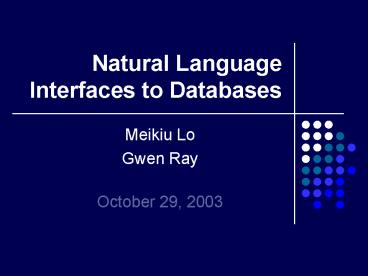Natural Language Interfaces to Databases - PowerPoint PPT Presentation
1 / 19
Title:
Natural Language Interfaces to Databases
Description:
... first good database natural language processing systems was developed by ... programming to construct natural language processing systems (CHILL system Mooney) ... – PowerPoint PPT presentation
Number of Views:939
Avg rating:3.0/5.0
Title: Natural Language Interfaces to Databases
1
Natural Language Interfaces to Databases
- Meikiu Lo
- Gwen Ray
- October 29, 2003
2
I. What is Natural Language Database Interface?
- allows users to access information stored in a
database by formulating request in Natural
Language. - Examples
- Who is the youngest employee in the sales
department? - Does any employee in the sales department
earn more than 35000?
3
Two Components
- Linguistic component
- translates Natural Language input into a formal
query and generating a natural language response
based on the results from the database search. - Database component
- Performs traditional database management functions
4
Simple Diagram of NLDBIS
Natural Language Input
- Linguistic Component
- Natural Language Understanding
- (morphological analysis, syntactic analysis,
semantic analysis, discourse analysis) - Natural Language Generation
Transfer to Database Language
Database Component
Response
5
Linguistic component
- Includes
- Natural Language Understanding
- Mapping the given input in the natural language
into a useful representation. - Natural Language Generation
- Producing output in the natural language from
some internal representation.
6
II. What is it related to, or what will affect?
- companies are now making their product databases
available online with a multitude of user
interfaces. - their accessibility to no-expert users is
desirable.
7
III. Why use Natural Language Interface to
Database?
- Widespread use of Database
- Accurate retrieval
8
IV. What and how did it start?
- 1973 -- The first NLDBIS was the LUNAR system
built by Woods. It used chemical analyses of moon
rocks. - By late 1970's -- first good database natural
language processing systems was developed by
LIFER/LADDER about US Navy Ships. This system
used a semantic grammar to parse questions and
query a distributed database.
9
IV. What and how did it start? (cont.)
- 1980-1990 -- NLDB systems became large, diverse
and represented completely different concept. - Recent -- commercial products have created NLDB
system to transfer written or spoken language
into database queries e.g., PDAs, cell phones.
Besides, multilingual natural language interfaces
have developed in the e-commerce environments.
10
V. Why is it important, and to whom?
- Database Users want ease reliability
accuracy of responses reduction in time spent
querying global accessibility. - Org.s/Companies improved customer service,
greater and global accessibility cost to employ
vs. savings. - Database Developers Administrators - Additional
database development human resources for
linguistic components development (including
multiple languages) Additional database
development testing for reliability and
performance and security.
11
VI. What is the current state?
- Web access
- Global access/multilingual
- Small devices PDAs, Cell Phones
- Less specialized, more varied databases
- Non-specialized database users
- Multiple databases
12
VI. What is the current state?(cont.)
- New natural language database interfaces for new
users! - New techniques/processes that will support the
wide variety of databases being accessed by a
wide variety of users, around the globe! - An example The Precise System designed by
computer scientists at the University of
Washington.
13
VI. Current stateThe Precise System
14
VI. Current stateThe Precise System (contd.)
15
VI. Current stateOther initiatives
- Spoken language dialogue systems.
- Tutorial systems.
- Large-scale dependency grammars which can include
semantic and morphologic information,
hierarchical statistical language models. - Inductive logic programming to construct natural
language processing systems (CHILL system
Mooney)
16
VII. What do you expect in the immediate future?
- More transportable natural language interfaces to
a wider spectrum of databases. - Improved natural language interface used with
improved voice recognition. - More appliances with natural language interfaces.
17
VIII. What are the implications for database
users, administrators, developers, and the
general public?
- Now that transportable NLIs are in development
that make the use of them more feasible across a
wider spectrum of databases, it is likely we will
see an expansion of the use of natural language
database interfaces. The trend is already afoot
and if users expect it, it will likely come.
18
VIII. Implications (cont.)
- Database Users
- Better or expanded customer service
- Ease of finding answers to questions
- Administrators
- Additional database development testing for
reliability and performance and security - Developers
- Additional database development human resources
for linguistic components development (including
multiple languages) - General Public
- Improved Global accessibility
19
The End.
- Questions?

